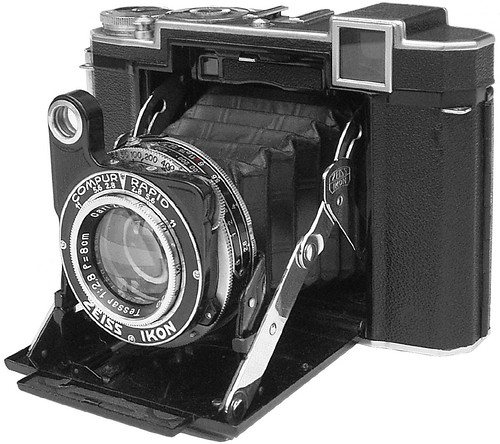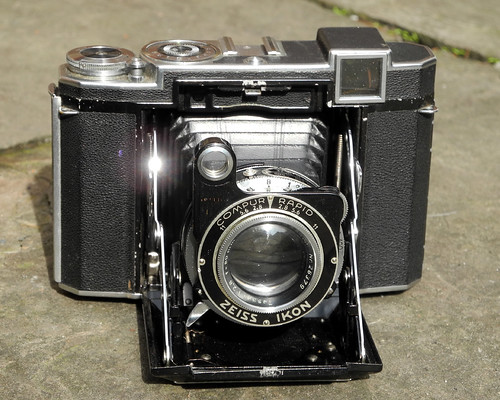Difference between revisions of "Super Ikonta 532/16"
m (Layout tidy up.) |
Hanskerensky (talk | contribs) (Added Category:Zeiss Ikon AG) |
||
| (8 intermediate revisions by 3 users not shown) | |||
| Line 9: | Line 9: | ||
The '''532/16''' is a folding camera in the [[Ikonta]] line, produced by the German company [[Zeiss Ikon]] from 1937-1955. It takes 11 size 6x6 cm images on [[120]] type [[rollfilm]]. The unusual number of frames, 11 instead of the standard 12, is caused by a design change which Zeiss Ikon made to encounter the frame overlapping problems which were encountered with its predeseccor the [[Super Ikonta 530/16]]. The Super Ikonta's are equiped with coupled rangefinders. It was generally sold under the name '''Super Ikonta I 6x6 cm''' and '''Super Ikonta I 2<small>1/4</small> x 2<small>1/4</small>''' | The '''532/16''' is a folding camera in the [[Ikonta]] line, produced by the German company [[Zeiss Ikon]] from 1937-1955. It takes 11 size 6x6 cm images on [[120]] type [[rollfilm]]. The unusual number of frames, 11 instead of the standard 12, is caused by a design change which Zeiss Ikon made to encounter the frame overlapping problems which were encountered with its predeseccor the [[Super Ikonta 530/16]]. The Super Ikonta's are equiped with coupled rangefinders. It was generally sold under the name '''Super Ikonta I 6x6 cm''' and '''Super Ikonta I 2<small>1/4</small> x 2<small>1/4</small>''' | ||
| − | The Super Ikonta line was launched after the [[Contax I]] and [[Zeiss Ikon Kolibri|Kolibri]] by Zeiss Ikon, due to Zeiss marketing recognizing that serious amateurs were interested in a larger film format than the Contax 35mm camera provided, but also wanted similar amounts of automation.<ref>Gubas, Larry, "The Super Ikontas" in Zeiss Historica - The Journal of the Zeiss Historica Society, Volume 4, Number 2 - Autumn, 1982</ref> The 6x6 Super Ikonta series (called Super Ikonta B) was launched in 1935 with the [[Super Ikonta 530/16]]. The 530/16 was then upgraded to the 532/16 in 1937, including a larger and combined rangefinder viewfinder, a 8cm f2.8 Tessar lens (there was no f3.5 model, as the 530/16 had) and an automatic film stop and couting mechanism. The 6x6 series (B-series) had an accessory shoe built-in, intended for the [[Contameter]] and [[Albada finder]].<ref>Gubas, Larry, "The Super Ikontas" in Zeiss Historica - The Journal of the Zeiss Historica Society, Volume 4, Number 2 - Autumn, 1982</ref> | + | The Super Ikonta line was launched after the [[Contax I]] and [[Zeiss Ikon Kolibri|Kolibri]] by Zeiss Ikon, due to Zeiss marketing recognizing that serious amateurs were interested in a larger film format than the Contax 35mm camera provided, but also wanted similar amounts of automation.<ref>Gubas, Larry, "The Super Ikontas" in Zeiss Historica - The Journal of the Zeiss Historica Society, Volume 4, Number 2 - Autumn, 1982</ref> The 6x6 Super Ikonta series (called Super Ikonta B) was launched in 1935 with the [[Super Ikonta 530/16]]. The 530/16 was then upgraded to the 532/16 in 1937, including a larger and combined rangefinder viewfinder, a 8cm f2.8 Tessar lens (there was no f3.5 model, as the 530/16 had) and an automatic film stop and couting mechanism. The 6x6 series (B-series) had an accessory shoe built-in, intended for the [[Contameter]] and [[Viewfinder#Albada_finders|Albada finder]].<ref>Gubas, Larry, "The Super Ikontas" in Zeiss Historica - The Journal of the Zeiss Historica Society, Volume 4, Number 2 - Autumn, 1982</ref> |
==Production== | ==Production== | ||
| Line 16: | Line 16: | ||
plant in Dresden before the war, and shipped to Stuttgart for acceptance testing and assembly into the cameras. After the war the rangefinder components were outsourced to [[Rodenstock]].<ref>Gubas, Larry, "The Super Ikontas" in Zeiss Historica - The Journal of the Zeiss Historica Society, Volume 4, Number 2 - Autumn, 1982</ref> | plant in Dresden before the war, and shipped to Stuttgart for acceptance testing and assembly into the cameras. After the war the rangefinder components were outsourced to [[Rodenstock]].<ref>Gubas, Larry, "The Super Ikontas" in Zeiss Historica - The Journal of the Zeiss Historica Society, Volume 4, Number 2 - Autumn, 1982</ref> | ||
| − | + | ==Specifications== | |
{{Flickr_image | {{Flickr_image | ||
| − | |image_source= | + | |image_source= https://www.flickr.com/photos/72498006@N00/6847913556/in/pool-camerawiki/ |
| − | |image= http:// | + | |image= http://farm8.staticflickr.com/7061/6847913556_db32d37456.jpg |
|image_align= right | |image_align= right | ||
|image_text= Super Ikonta 532/16 (postwar) | |image_text= Super Ikonta 532/16 (postwar) | ||
| − | |image_by= | + | |image_by= Steve Davies |
|image_rights= with permission | |image_rights= with permission | ||
}} | }} | ||
* Production period : 1937 to 1955 | * Production period : 1937 to 1955 | ||
* Format : 6 x 6 cm on [[120]] type [[rollfilm]] | * Format : 6 x 6 cm on [[120]] type [[rollfilm]] | ||
| − | * Known Lens/Shutter combinations (prewar): <br/>Tessar 2.8/8.0 cm lens in a [[Compur-Rapid]] shutter | + | * Known Lens/Shutter combinations (prewar): <br/>[[Tessar]] 2.8/8.0 cm lens in a [[Compur-Rapid]] shutter |
* Known Lens/Shutter combinations (postwar): <br/>Tessar 2.8/80 mm lens in a [[Compur-Rapid]] or [[Synchro-Compur]] shutter | * Known Lens/Shutter combinations (postwar): <br/>Tessar 2.8/80 mm lens in a [[Compur-Rapid]] or [[Synchro-Compur]] shutter | ||
* Filter Size : ? | * Filter Size : ? | ||
| Line 52: | Line 52: | ||
<references/> | <references/> | ||
== Links == | == Links == | ||
| − | * [http://www.davidrichert.com/zeiss_super_ikonta.htm Super Ikonta B 532/16 manual] on [http://www.davidrichert.com/ David Richert's website] | + | * [https://web.archive.org/web/20140409170447/http://www.davidrichert.com/zeiss_super_ikonta.htm Super Ikonta B 532/16 manual] on [https://web.archive.org/web/20150418041009/http://www.davidrichert.com/ David Richert's website] (archived) |
| + | *[https://www.35mmc.com/28/11/2022/super-ikonta-532-16-review-an-ikon-by-bob-janes/ Super Ikonta 532/16 review] at [https://www.35mmc.com/ 35mmc.com] | ||
{{br}} | {{br}} | ||
| − | [[Category:German 6x6 rangefinder folding]] [[Category: | + | [[Category:German 6x6 rangefinder folding]] |
| + | [[Category:120 film]] | ||
| + | [[Category:S]] | ||
| + | [[Category:Super]] | ||
| + | [[Category:Zeiss Ikon]] | ||
| + | [[Category:Zeiss Ikon AG]] | ||
| + | [[Category:1937]] | ||
Latest revision as of 03:42, 4 April 2024

|
| Super Ikonta 532/16 (prewar) image by Alf Sigaro (Image rights) |
The 532/16 is a folding camera in the Ikonta line, produced by the German company Zeiss Ikon from 1937-1955. It takes 11 size 6x6 cm images on 120 type rollfilm. The unusual number of frames, 11 instead of the standard 12, is caused by a design change which Zeiss Ikon made to encounter the frame overlapping problems which were encountered with its predeseccor the Super Ikonta 530/16. The Super Ikonta's are equiped with coupled rangefinders. It was generally sold under the name Super Ikonta I 6x6 cm and Super Ikonta I 21/4 x 21/4
The Super Ikonta line was launched after the Contax I and Kolibri by Zeiss Ikon, due to Zeiss marketing recognizing that serious amateurs were interested in a larger film format than the Contax 35mm camera provided, but also wanted similar amounts of automation.[1] The 6x6 Super Ikonta series (called Super Ikonta B) was launched in 1935 with the Super Ikonta 530/16. The 530/16 was then upgraded to the 532/16 in 1937, including a larger and combined rangefinder viewfinder, a 8cm f2.8 Tessar lens (there was no f3.5 model, as the 530/16 had) and an automatic film stop and couting mechanism. The 6x6 series (B-series) had an accessory shoe built-in, intended for the Contameter and Albada finder.[2]
Production
The Ikonta cameras were produced in the previous Contessa-Nettel plant in Stuttgart, as the Dresden plant was busy with the Contax and other 35mm cameras. Stuggart coordinated the amount of cameras to be produced with Zeiss Ikon in Dresden. The camera bodies and bellows were produced in Stuttgart, shutters were ordered from Friedrich Deckel in Munich and shipped to Carl Zeiss Jena, who mounted the lens into the shutters. Then the lens and shutter assembly was shipped to Stuttgart for mounting to the body. Rangefinder components were manufactured in the Ernemann plant in Dresden before the war, and shipped to Stuttgart for acceptance testing and assembly into the cameras. After the war the rangefinder components were outsourced to Rodenstock.[3]
Specifications

|
| Super Ikonta 532/16 (postwar) image by Steve Davies (Image rights) |
- Production period : 1937 to 1955
- Format : 6 x 6 cm on 120 type rollfilm
- Known Lens/Shutter combinations (prewar):
Tessar 2.8/8.0 cm lens in a Compur-Rapid shutter - Known Lens/Shutter combinations (postwar):
Tessar 2.8/80 mm lens in a Compur-Rapid or Synchro-Compur shutter - Filter Size : ?
- Flash synchronisation (only postwar) : Socket on shutter, X-synchronisation. Synchro-Compur also M-synchronisation
- Selftimer : Yes
- Lighmeter system : none
- Double exposure prevention : Yes
- Rangefinder : Coupled, rotating wedge. Window combined with viewfinder window.
- Viewfinder : reverse Galilean type, integrated in top cover
- Color Finish : Black with chrome ornaments
- Color Leatherette : Black
- Dimensions WxHxD : 147x96x48 mm (folded)
- Weight: 990 grams
Bibliography
- Bernd K.Otto, Article "Die Entwicklung der Ikonta/Super Ikonta (1)" in the German magazine Photo Deal Nr.46 III/2004
- Bernd K.Otto, Article "Die Entwicklung der Ikonta/Super Ikonta (2)" in the German magazine Photo Deal Nr.47 IV/2004
- Zeiss Ikon brochure (Swedish) "tusen och ett motiv" 1945-4, page 9
- Photo Porst Catalog (German) 1952, page 115
Notes
- ↑ Gubas, Larry, "The Super Ikontas" in Zeiss Historica - The Journal of the Zeiss Historica Society, Volume 4, Number 2 - Autumn, 1982
- ↑ Gubas, Larry, "The Super Ikontas" in Zeiss Historica - The Journal of the Zeiss Historica Society, Volume 4, Number 2 - Autumn, 1982
- ↑ Gubas, Larry, "The Super Ikontas" in Zeiss Historica - The Journal of the Zeiss Historica Society, Volume 4, Number 2 - Autumn, 1982
Links
- Super Ikonta B 532/16 manual on David Richert's website (archived)
- Super Ikonta 532/16 review at 35mmc.com